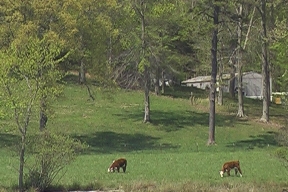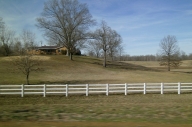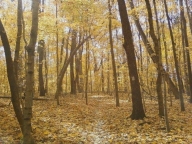Rural Areas
The areas located outside of cities and towns are termed “rural”. Rural areas have low population density. Rural areas often have a lot of undeveloped land, farmland or forest. Most of the land area in Tennessee is rural. Based on the 2010 Census, 93% of Tennessee is rural. Some 70 of 95 counties had at least 50% of their residents living in the 38,330 square miles of rural Tennessee. People in rural areas have unique differences and challenges when it comes to economic and community development and health. Rural areas often have fewer service providers and resources for jobs, health care and community services.

What is different about rural health?
How can rural areas encourage physical activity and health?
What is a health disparity?
What is my area Developmental District?
What is my area Human Resource Agency?
What is the Rural Task Force?
Where are Tennessee’s rural communities?
Why conserve rural green space?
What about economic development?
What about rural housing?
What is different about rural data?
Government partners
Additional resources
Helpful documents
What is different about rural health?
Health is greatly influenced by place, because of the environmental and cultural characteristics of neighborhoods and communities. Environmental and cultural factors unique an area influence behaviors and health. People living in rural, suburban and urban areas have different levels of access to nutritious food, spaces for physical activity and recreation, utilities such as water and sewer, health care, dental care, transportation and even digital telecommunications. Rural communities often have fewer job opportunities and lower wages. Overall, rural residents are at greater risk for poor health outcomes, with higher rates of preventable conditions such as obesity, diabetes and injury and higher rates of unhealthy behaviors such as smoking, physical inactivity and poor nutrition.
The Tennessee Department of Health is committed to improving the health and well-being of our rural residents. The Tennessee Office of Rural Health was established to identify obstacles unique to rural areas, including information, technical assistance and even funding to identify and address the needs in underserved areas, to attract and retain qualified health professionals, and to ensure viability and collaboration among small rural hospitals and service providers in order improve and enhance the health of rural citizens.
How can rural areas encourage physical activity and health?
While residents of rural communities who are close to agricultural enterprises enjoy greater access to healthy foods and active lifestyles, facilities such as gyms and tracks may be less accessible than in urban areas. Rural residents, churches, businesses and civic organizations often join forces to build and maintain parks, playgrounds and sports fields where children and adults can engage in physical activities. Some schools have adopted policies which allow use of playgrounds and ballfields during non-school hours. Other communities have established safe routes for walkers and bikers to use on their way to public buildings and shopping areas—including farmers’ markets. Many organize special events and promote use of their beautiful natural environment by residents and visitors, with signage, lighting and other amenities for hiking trails and other recreational areas. Together, these resources not only help rural communities become healthier, but they may also increase revenue and job opportunities through tourism.
What is a health disparity?
According to the CDC, health disparities are preventable differences in the burden of disease, injury, violence or opportunities to achieve optimal health that are experienced by socially disadvantaged populations. Health disparities can arise from environmental factors such as limited access to health care and other services, poor water or air quality, substandard housing and unsafe neighborhoods. Health disparities may also be related to poverty arising from lack of education or employment opportunities. Certain disparities exist for different genders, ages, races and cultural backgrounds, and also for behavioral factors such as tobacco use, substance abuse and unprotected sex. Several health disparities have been identified among people who live in rural areas including access to primary medical, mental health and oral health care services and also for emergency services. CDC’s Action Steps to Address Health and Educational Disparities are designed for use by state and local education and health agencies to address disparities.
What is my area Development District?
Development Districts serve as the regional clearinghouses for federal programs in support of economic, housing and community development initiatives. Development Districts bring elected leaders from cities and counties together with leaders from other community organizations to address regional issues and to promote economic development. There are nine Development Districts in the State of Tennessee For more information, visit the Tennessee Development District Association's website.

Human Resource Agencies deliver social services across the state to ensure that people have a sense of self-worth and wellbeing. Their services cover a broad range of human needs, including services for children and youth, elderly and disabled: community services, community intervention, education and employment, nutrition; housing, transportation and healthcare. There are ten Human Resource Agencies in Tennessee.
What is the Rural Task Force?

The Governor’s Rural Task Force was formed in fall 2015 for the purpose of bringing resources together from a wide range of organizations to advance rural communities and economic development. The Rural Task Force plans to assist with issues that impact rural life. It is making a comprehensive plan for rural development. It will engage with stakeholders to continuously improve education, health, entrepreneurial opportunities, digital infrastructure and economic and workforce development.
Where are Tennessee’s rural communities?
The diversity of Tennessee’s communities should not be overlooked: rural communities differ significantly from urban and suburban communities, not just in population size but also in demographics and culture.
For example, Eastern Tennessee shares in the rich history and culture of the Appalachian Mountain region, where residents have been characterized as proud and independent, preferring to take care of themselves without outside help. Rural communities in this region are characterized by low population density and limited economic opportunity, coupled with low educational achievement, limited access to health care and poor health. Appalachian residents can be faced with the dilemma of health risks related to the jobs available in their communities, such as coal mining. Compared to other parts of the state, Appalachian residents have been shown to suffer from higher rates of heart disease, premature mortality and other health conditions, which must be addressed through approaches as unique as their mountain places.
On the other end of the state, rural residents in Western Tennessee’s Delta Region face the same challenges of limited economic opportunities and education, in addition to the greater risk of natural disasters such as flooding and tornadoes. Representing a large percentage of the population, African-Americans and other minorities suffer from disproportionately high rates of obesity and premature death from diabetes and certain cancers, and lack health literacy which might lead to earlier detection and treatment.
Why conserve rural green space?

Rural communities tend to grow more slowly than metropolitan areas. Even though there may appear to be unlimited green space in the countryside, environmental changes frequently occurs and causes problems for these communities. Rapid loss of rural lands due to uncontrolled growth can undermine property values. Sprawling development can ruin important natural areas such as wetlands, prairies and forests. Conservation of rural lands protects the air, land and water from environmental pollution which is harmful to health. Green spaces such as wildlife refuges and state forests protect plants and animals. Conservation areas protect the scenic views which attract tourists, along with the jobs and economic opportunities created through spaces hiking, hunting, fishing, bird watching and nature observation.
There are several options for preserving green space. Conservation development is controlled-growth land use that protects the area's natural environmental in perpetuity by preserving landscapes, sustaining farmland, protecting natural habitats for wildlife and maintaining the character of rural communities. Land trusts are voluntary conservation easements. Land trusts safeguard the land from development and sprawl. Families who have passed down the same property from generation to generation often like entering into a land trust to know their family home will remain similar to how they remember it. In addition to improved property values, many people feel their quality of life is improved when there is protected green space nearby.
What about economic development?
There are resources available to help increase economic development in rural communities. The Department of Agriculture and the Department of Economic and Community Development both promote food and agribusiness. Ag's Business Development Division works with producers and agribusiness to build rural economies through diverse growth and development activities. ECD’s Rural Development programs fund initiatives to connect communities to advance economic development through funding and technical assistance.
What about rural housing?
Healthy housing is important to maintaining good health and wellness. In some rural areas, housing, especially affordable housing, can be limited. The U.S. Department of Agriculture has a rural development program. USDA assists with some 360 multi-family properties in Tennessee. If you have a question about living in USDA-assisted rural housing you can contact your rural development local office. If you are looking for assistance about buying or renting, the Tennessee Housing Development Agency may have a program to help.
What is different about rural data?
Rural areas share the common characteristics of comparatively few people living in an area. In communities with small population sizes, there may be a very limited number of cases reported for any issue, and even one case more or less may make a big difference in the percentage of change calculated from year to year, diluting or masking trends in rural population data. Where the number of cases is so small that anyone familiar with the community might be able to identify the individual’s identity from that data, officials are prohibited from releasing that data in order to protect the individual’s privacy. In those cases, data is “suppressed” and not made publicly available. For example, the Federal Office of Rural Health Policy, which funds the Rural Health Information Hub to be a clearinghouse on rural health issues, might lack data for some communities and some conditions.
Government Partners
Tennessee Department of Health
Rural Health
www.tn.gov/health/health-program-areas/rural-health.html
Tennessee Department of Economic & Community Development (ECD)
www.tn.gov/ecd.html
Tennessee Department of Agriculture (Ag)
tn.gov/agriculture
U.S. Department of Agriculture (USDA)
Rural Development, natural resource conservation
rd.usda.gov
Resource Conservation and Development Areas
www.nrcs.usda.gov/wps/portal/nrcs/detail/national/technical/nra/nri/?&cid=nrcs143_013723
U.S. Department of Health & Human Services, Health Resources and Services Administration (HRSA)
Federal Office of Rural Health Policy
www.hrsa.gov/ruralhealth
U.S. Environmental Protection Agency (EPA)
Smart Growth in Small Towns and Rural Communities
www.epa.gov/smartgrowth/smart-growth-small-towns-and-rural-communities
Additional resources
Rural Health Association of Tennessee
www.rhat.org
Tennessee Center for Workforce Development
tncwd.com
Rural Health Information Hub
www.ruralhealthinfo.org/states/tennessee
Center for Rural Strategies
www.ruralstrategies.org
The Land Trust for Tennessee
landtrusttn.org
Tennessee Recreation and Parks Association
Benefits of Parks and Recreation
www.trpa.net
National Agricultural Library
What is Rural?
ric.nal.usda.gov/what-rural
Helpful documents
U.S. Environmental Protection Agency
Smart Growth Self-Assessment for Rural Communities: Madison County, New York
PDF
U.S. Environmental Protection Agency
Federal Resources for Sustainable Rural Communities
PDF
U.S. Department of Transportation, Federal Highway Administration
Small Town and Rural Multimodal Networks
PDF
Tennessee Department of Health & Nashville Civic Design Center
Main Street Transect Infosheet
PDF